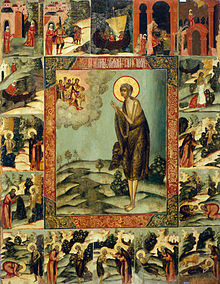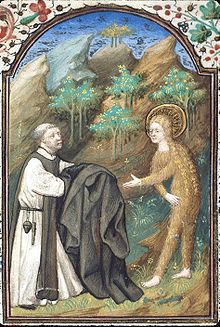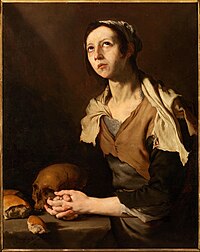writings of the saints and lives of the saints
st mary of egypt
Mary of Egypt
From Wikipedia, the free encyclopedia
Jump to navigation
Jump to search
| Mary of Egypt | |
|---|---|

18th-century Russian icon of Saint Mary of Egypt
| |
| Venerable | |
| Born |
c. 344 Province of Egypt |
| Died |
c. 421 Trans-Jordan desert, Palestine (Modern Day Israel) |
| Venerated in |
Eastern Orthodox Church Oriental Orthodoxy Roman Catholic Church Anglican Communion |
| Feast |
Orthodox: 1 April;[1] 5th Sunday of Great Lent Roman Catholic: 1 April Coptic Orthodox: Parmouti 6 [2] |
| Patronage | Chastity (warfare against the flesh; deliverance from carnal passions); Demons (deliverance from); Fever; Skin diseases; Temptations of the flesh[3] |
Contents
Life
Icon of Saint Mary of Egypt, surrounded by scenes from her life (17th century, Beliy Gorod).
Saint Mary, also known as Maria Aegyptiaca, was born somewhere in the Province of Egypt, and at the age of twelve she ran away from her parents to the city of Alexandria. Here she lived an extremely dissolute life.[4] In her Vita it states that she often refused the money offered for her sexual favors, as she was driven "by an insatiable and an irrepressible passion," and that she mainly lived by begging, supplemented by spinning flax.
Coptic icon of Mary of Egypt
Approximately one year before her death, she recounted her life to Saint Zosimas of Palestine,[6] who encountered her in the desert. When he unexpectedly met her in the desert, she was completely naked and almost unrecognizable as human. She asked Zosimas to toss her his mantle to cover herself with, and then she narrated her life's story to him. She asked him to meet her at the banks of the Jordan, on Holy Thursday of the following year, and bring her Holy Communion. When he fulfilled her wish, she crossed the river to get to him by walking on the surface of the water, and received Holy Communion, telling him to meet her again in the desert the following Lent. The next year, Zosimas travelled to the same spot where he first met her, some twenty days' journey from his monastery, and found her lying there dead. According to an inscription written in the sand next to her head, she had died on the very night he had given her Communion and had been somehow miraculously transported to the place he found her, and her body was preserved incorrupt. He buried her body with the assistance of a passing lion. On returning to the monastery he related her life story to the brethren, and it was preserved among them as oral tradition until it was written down by St. Sophronius.
Icon of Mary of Egypt, covered in golden hair, being handed a cloak by Zosimas, French, 15th century (British Library)
Date of death
There is disagreement among various sources regarding the dates of Saint Mary's life. The dates given above correspond to those in the Catholic Encyclopedia. The Bollandists place her death in 421, others give the date of her death as 522 (see Orthodox Wiki article, below) or 530 (see Prolog from Ohrid, April 1). The only clue given in her Vita is the fact that the day of her repose was April 1, which is stated to be Holy Thursday, meaning that Easter fell on April 4 that year.If one consults a perpetual calendar that is keyed to the Julian Calendar (the one in use at the time), one finds that there are 24 years[7] in the relevant centuries on which April 1 occurs on a Thursday.[8] Of these, the years on which Easter would fall on April 4 according to the Julian Calendar are: 443, 454, 527, 538, and 549.[9] (Alternatively, one could interpret her death occurring during the "night of our Lord's Passion" as indicating that her death occurred on Good Friday. That is consistent with the Orthodox date for her death in 522, when Easter was on April 3.)
It is notable that the Synaxarion states that Zosimas lived during the reign of the Emperor Theodosius the Younger,[10] who reigned from 408 to 450. According to tradition, Zosimas lived almost a hundred years, dying in the sixth century, and the Vita states that he was fifty-three years old when he met Saint Mary.
Religious commemoration
The Temple of Portunus, Rome, was preserved by being rededicated to Santa Maria Egiziaca in 872.
Her feast day is kept by the Orthodox according to the Fixed Cycle on April 1. On the Moveable Cycle, the Orthodox Church also commemorates her on the fifth Sunday of Great Lent,[11] on which day it is customary for the priest to bless dried fruit after the Divine Liturgy. The Life of St Mary, by Saint Sophronius, is appointed to be read during the Matins of the Great Canon of Saint Andrew of Crete on the preceding Thursday.
In the Catholic Church, she is listed in the 2004 edition of the Roman Martyrology on April 1. Although she is venerated by Anglicans, Saint Mary of Egypt does not appear on Anglican Church Calendars.
In Italy, this Mary became associated with the patronage of fallen women much like Mary Magdalene, to whom similar traits were associated. There are a number of churches or chapels dedicated to Saint Mary of Egypt, among them:
- Temple of Portunus (Santa Maria Egiziaca, Rome)
- Church of Santa Maria Egiziaca a Forcella, Naples
- Church of Santa Maria Egiziaca a Pizzofalcone, Naples
- Chapel in Church of the Holy Sepulchre in Jerusalem, commemorating the site of her conversion.
Cultural references
Mary of Egypt, by José de Ribera
In Ben Jonson's play Volpone (1606) one of the characters uses the expression "Marry Gip." Commentators have taken this to mean "Mary of Egypt."
Mary of Egypt is the subject of operas by Ottorino Respighi (Maria egiziaca) and Sir John Tavener (Mary of Egypt), the latter written in 1992 for the Aldeburgh Festival.
The Unknown Masterpiece (1831), a novella by Balzac, contains a long description of a portrait of Mary of Egypt "undressing in order to pay her passage to Jerusalem."
Nalo Hopkinson's science fiction novel, The Salt Roads, also features Mary of Egypt and takes a historical fiction approach to telling her story.
In John Berryman's Pulitzer Prize winning book of poetry, The Dream Songs, poem 47, subtitled "April Fool's Day, or, St. Mary of Egypt," recounts Mary of Egypt's walk across the River Jordan.
"Thrust back by hands of air from the sanctuary door" is the first line of Maria Aegyptiaca, a poem by John Heath-Stubbs about the saint (Collected Poems, p. 289).
See also
Notes
- "Orthodox Research Institute". Orthodox Research Institute.
External links
| Wikimedia Commons has media related to Mary of Egypt. |
- Original Vita of Saint Mary of Egypt by Saint Sophronius, as read in Orthodox churches on Thursday of the fifth week of Great Lent
- Original Vita of Saint Mary of Egypt by Saint Sophronius, as read in Orthodox churches on Thursday of the fifth week of Great Lent
- Saint Mary the Egyptian from the Prologue from Ohrid, April 1
- The Golden Legend: The Life of Saint Mary of Egypt (In Persian, with English translation)
- Fifth Sunday of Great Lent: Saint Mary of Egypt icon and synaxarion
- Mary of Egypt Orthodox Wiki
- "St. Mary of Egypt: Ascent From Prostitution to Sanctity" from Harlots of the Desert, by Sr. Benedicta Ward
Navigation menu
Interaction
Tools
Print/export
In other projects
Languages
- This page was last edited on 21 September 2018, at 20:39 (UTC).
- Text is available under the Creative Commons Attribution-ShareAlike License; additional terms may apply. By using this site, you agree to the Terms of Use and Privacy Policy. Wikipedia® is a registered trademark of the Wikimedia Foundation, Inc., a non-profit organization.
writings of the saints and lives of the saints
GOOGLE DRIVE
Writing of the saints and lives of the saints
Google drive 1
https://drive.google.com/drive/folders/0ByTtqjBdrjn8S200MVdQMG5KRnc?usp=sharing
Google drive 2
https://drive.google.com/drive/folders/0B5bEXpIVFX77NEtxQk1YZTJaSDQ?usp=sharing
Google drive 3
https://drive.google.com/drive/folders/0Byn2kJ3M-e4Jc200X1ZLOVduOGM?usp=sharing
Google drive 4
https://drive.google.com/drive/folders/0B9gctGsDA6_OWnpEOFNER1UtVkk?usp=sharing
Google drive 5
https://drive.google.com/drive/folders/0B95V8xlfNaKlWkNWamFCWmszRUU?usp=sharing
Writing of the saints and lives of the saints by alphabetical order
Google drive 6
https://drive.google.com/drive/folders/0BwjR4ScY-39jMTh3cTMwVnVEdU0?usp=sharing
Google drive 7
https://drive.google.com/drive/folders/0B-kDl5W8TV3bS1R0MlItN0huVVk?usp=sharing
Google drive 8
https://drive.google.com/drive/folders/0B6J-IvkAkynNY1F5OTJvVktacTg?usp=sharing
Google drive 9
https://drive.google.com/drive/folders/0B8YtYYJyfmXkdG1QVHFyVnVHcEE?usp=sharing
Google drive 10
https://drive.google.com/drive/folders/0BwqdZN-mNVLaS2pOV25taElUZkk?usp=sharing
Bibles
https://drive.google.com/drive/folders/0B87zkxGkLRQcTnhuRTI2dlhMbGM?usp=sharing
Writing of the saints and lives of the saints
Google drive 1
https://drive.google.com/drive/folders/0ByTtqjBdrjn8S200MVdQMG5KRnc?usp=sharing
Google drive 2
https://drive.google.com/drive/folders/0B5bEXpIVFX77NEtxQk1YZTJaSDQ?usp=sharing
Google drive 3
https://drive.google.com/drive/folders/0Byn2kJ3M-e4Jc200X1ZLOVduOGM?usp=sharing
Google drive 4
https://drive.google.com/drive/folders/0B9gctGsDA6_OWnpEOFNER1UtVkk?usp=sharing
Google drive 5
https://drive.google.com/drive/folders/0B95V8xlfNaKlWkNWamFCWmszRUU?usp=sharing
Writing of the saints and lives of the saints by alphabetical order
Google drive 6
https://drive.google.com/drive/folders/0BwjR4ScY-39jMTh3cTMwVnVEdU0?usp=sharing
Google drive 7
https://drive.google.com/drive/folders/0B-kDl5W8TV3bS1R0MlItN0huVVk?usp=sharing
Google drive 8
https://drive.google.com/drive/folders/0B6J-IvkAkynNY1F5OTJvVktacTg?usp=sharing
Google drive 9
https://drive.google.com/drive/folders/0B8YtYYJyfmXkdG1QVHFyVnVHcEE?usp=sharing
Google drive 10
https://drive.google.com/drive/folders/0BwqdZN-mNVLaS2pOV25taElUZkk?usp=sharing
Bibles
https://drive.google.com/drive/folders/0B87zkxGkLRQcTnhuRTI2dlhMbGM?usp=sharing
Langganan:
Komentar (Atom)











